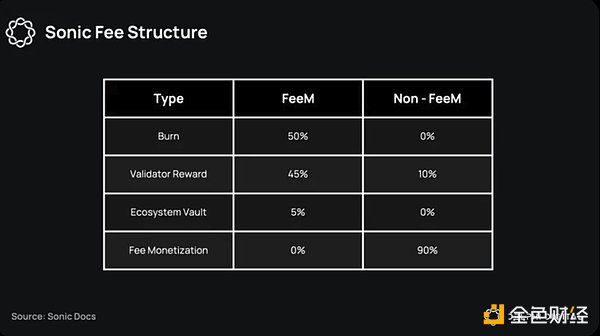
Author: Delphi Digital Source: X, @Delphi_Digital Translation: Shan Oppa, Golden Finance
Blockchain competition has entered a new stage. The early L1 & L2 battles revolved around decentralization, composability and security, and today the battlefield has turned to purely performance competition.
Multiple EVM compatibility chains such as Sonic, MegaETH, Fuel, Monad, and Sei are breaking through the limits of scalability that were once considered impossible. So, can you win the market by relying solely on performance advantages? This analysis will explore the strategic differences between each chain.
Sonic: Binding revenue with developer influenceSonicLabs (formerly Fantom) has undergone a strategic transformation, emphasizing developer incentives rather than simple throughput. Its innovative mechanism, Fee Monetization (FeeM), allows developers to obtain up to 90% of transaction fees, and the remaining 10% belongs to the verifier.
This model is changing the Sonic ecosystem. For example, @ShadowOnSonic quickly became the top four DEX in Sonic's ecosystem in the top four weekly revenue, far exceeding expectations. In addition, Sonic attracts users through incentive programs, and some of the tokens are airdropped to DeFi application users and users holding whitelisted assets. This multi-level strategy is now successful, with TVL (total lock-in value) climbing to an all-time high of $962 million.
Competitive advantages:
Economic incentives directly bind developers to enhance loyalty.
The high-yield-driven application ecosystem helps users stay for a long time.
Early adopted data shows that the strategy has been initially effective.
Challenge:
The current degree of decentralization is still limited (about 35-40 validators).
Fantom The impact of early brand crisis has not been completely eliminated, and market trust is required to continue to accumulate.
MegaETH: The combination of ultimate speed and excellent user experienceMegaETH test network data is by far the strongest performance, with a block time of only 0.1 milliseconds. As L2, MegaETH achieves this performance improvement by removing the consensus layer.
But MegaETH's strategy is not just about pursuing extreme speeds. It also leads in supporting EIP-7702, bringing UX improvements such as transaction batch processing and Gas abstraction.
Since 2020 Ethereum users have lost over $300 million in token licensing over the year, and MegaETH significantly reduces the friction costs of user interaction by improving the transaction process.
In addition, MegaETH is closely aligned with the community through fair token allocation, which is in stark contrast to the traditional VC-led financing model. In June 2024, MegaETH raised $20 million from VC. Since then, it raised $10 million in 3 minutes at a valuation of $200 million on @echodotxyz. 10,000 ETH was subsequently raised (worth 2,700 at the time) through an NFT issuance.
Competitive advantage:
Leading technology, outstanding test network data performance.
Be the first to adopt EIP-7702 to improve user experience.
Community-driven fair token allocation to enhance user loyalty.
Challenge:
Rely on EigenDA (data availability layer).
left;">Performance data needs to be verified by the real environment.
Monad: Ecosystem firstMonad has not been online yetMainnet, but has established a strong ecological cooperation network, and plans to enter the market with complete infrastructure.
Monad has significant advantages in the currently highly competitive blockchain market by giving priority to improving the ecosystem and ensuring immediate liquidity, user growth and developer support after it goes online.
Cooperation includes:
•Phantom Wallet will support Monad from the first day.
• Top DeFi protocols: Uniswap, Balancer, Ambient Finance.
•Cross-chain infrastructure: LayerZero, Wormhole, Orbiter.
Competitive advantage:
The complete ecosystem ensures rapid user growth.
High quality infrastructure and liquidity support.
Challenge:
Early momentum needs to be quickly transformed into continuous user and developer appeal.
Sei: Developer-first strategySeiNetwork mainly bets on the developer ecosystem, and achieves high scalability internally through deep optimization of consensus and storage layers. Additionally, Sei provides funding and incentives for early stage developers and projects. However, ecological growth has not yet matched its technical strength and currently lacks a representative application and user base. Sei needs to transform technological potential into actual ecological success, which is the main challenge it faces in the near term.
Competitive advantages:
The technical foundation is solid and the scalability has been verified.
Focus on developer incentives and provide special funding support.
Challenge:
Self-effective in practical applications, initialUser growth is slow.
There is a lack of flagship applications and ecological narrative has not yet been established.
Fuel: Break through Ethereum's limitationsFuel_network's upcoming Alt-DA L2 (alternative data availability layer 2) project "Redacted", breaking away from Ethereum's limited data availability (DA) layer, aiming to achieve a high throughput of 150,000 TPS. This marks Fuel's shift from Ethereum alignment strategy to a more radical scalability solution.
Conclusion: Who is the real winner if you surpass throughput?At present, the market's valuation of tokens for these new chains is still unclear, but the L1 and L2 markets have become saturated. As chains compete in liquidity, applications, developers and users, valuations may tend to decline.
When ultra-large-scale Gas processing capabilities become the industry standard, the real winners will be those public chains that not only rely on throughput, but also provide faster speed, better incentives, better user experience, more mature ecology and stronger security.
The "Gigas" battle is intensifying, but the final outcome will be determined by a comprehensive factor far exceeding the throughput.











